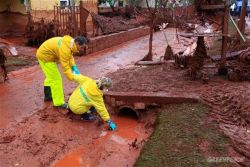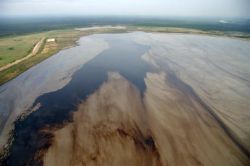When a tailings dam burst at an alumina plant in Hungary, more than 700,000 cubic metres of red toxic sludge was released into a river, killing eight people, injuring 120 and forcing the evacuation of 800 residents.
Sadly, the tailings dam failure in Hungary is not unique. Every year between two and five of the more than 3,500 tailings dams in the world experience major failures. Tailings dams are more than 10 times more likely to fail than conventional hydro or irrigation dams, yet their failures are potentially more dangerous because of the toxic substances they contain.
 In Canada, there have been a number of major tailings dam accidents. In 2004, more than 6,000 cubic metresof tailings spilled at a former mercury mine at Pinchi Lake, B.C. In 2008, a dam at the Opemiska copper mine near Chapais, Quebec burst, releasing an unknown volume of tailings.
In Canada, there have been a number of major tailings dam accidents. In 2004, more than 6,000 cubic metresof tailings spilled at a former mercury mine at Pinchi Lake, B.C. In 2008, a dam at the Opemiska copper mine near Chapais, Quebec burst, releasing an unknown volume of tailings.
Ironically, the day after the Hungarian disaster, before news made it to Canada, I was presenting evidence about tailings dam emergency planning at a hearing into a new Canadian oilsands mine being proposed by the French energy company Total SA.
[youtube:xEMWh6EjJoY,width=250]
In the hearing, I raised the issue that no emergency planning is carried out before a mine is approved. This is a problem because a project can be approved without addressing its risks. The federal and provincial panel repeatedly asked Total how they plan to address the consequences of a variety of accidents, including a tailings dam failure. Total declined to provide any additional information on their emergency planning and indicated that they will create a plan after the project has been approved
 The public needs to be assured that Total, or any of the other oilsands mining operations, will have a better emergency response plan than the alumina plant in Hungary. The Pembina Institute has researched the emergency planning regulations for oilsands tailings dams in our recently released report Northern Lifeblood. There is a major problem with the lack of transparency in emergency planning in Alberta. Current regulations allow oilsands mines to keep all emergency planning documents confidential. Many of these documents are not even readily accessible to the Government of Alberta (see chart). It is very difficult or impossible for independent experts to determine if the emergency plans are adequate.
The public needs to be assured that Total, or any of the other oilsands mining operations, will have a better emergency response plan than the alumina plant in Hungary. The Pembina Institute has researched the emergency planning regulations for oilsands tailings dams in our recently released report Northern Lifeblood. There is a major problem with the lack of transparency in emergency planning in Alberta. Current regulations allow oilsands mines to keep all emergency planning documents confidential. Many of these documents are not even readily accessible to the Government of Alberta (see chart). It is very difficult or impossible for independent experts to determine if the emergency plans are adequate.
|
Document |
Responsible Government Department |
Availability |
|
Canadian Dam Association - Dam Safety Guidelines |
Canadian Dam Association |
Public |
|
Emergency Preparedness Plan |
Dam Safety Section - Alberta Environment |
Confidential |
|
Emergency Response Plan |
Held by dam operator, disclosed to Government of Alberta upon request by the Province |
Confidential |
|
Operation, Maintenance and Surveillance Manuals |
Held by dam operator, disclosed to Government of Alberta upon request by the Province |
Confidential |
|
Annual Tailing Dam Performance Report |
Held by dam operator, disclosed to Government of Alberta upon request by the Province |
Confidential |
|
5 year - Tailing Dam Safety Review |
Held by dam operator, disclosed to Government of Alberta upon request by the Province |
Confidentia |
Accessibility of tailings dam management documents in Alberta. Source: Northern Lifeblood, 23.
Considering the recent tailings dam failure in Hungary and the BP oil spill over the summer, the transparency of emergency planning of oil sands tailings dams needs to be improved. Public interest should be put ahead of corporate interest. The thousands of people living downstream of the oil sands should be able to trust that both government and industry are prepared to act if an accident were ever to occur at a tailings dam here.









